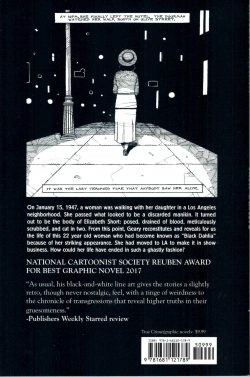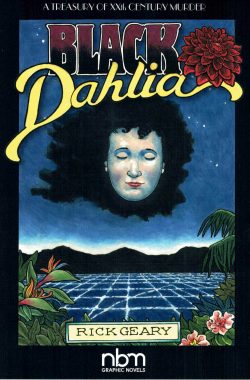

By Rick Geary (NBM)
ISBN: 978-1-68112-178-9
Win’s Christmas Gift Recommendation: Thrills and Chills for the Holiday Leisure Season… 9/10
Sometimes you just can’t get enough of a good thing. I’ve never wavered in my admiration for the work of Rick Geary and having two of his best both back in time for Christmas is splendid thinking on the part of publisher NBM.
First read our review of The Terrible Axe-Man of New Orleans from last week for the usual peroration and guidance. then hunker down here for a briefing on one of the most infamous and culturally significant unsolved murder mysteries in American – if not world – history.
Geary’s unique gifts have never been better utilised than here in this graphic reprise and documentary deconstruction from his ongoing series Treasury of XXth Century Murder: focusing on the Noir-informed, post-war scandal of Elizabeth Short: forever immortalised as the Black Dahlia…
Delivered as always in stark, uncompromising monochrome (in luxurious collectors’ hardback, accessible eBook or this welcome new paperback edition), his deliberations diligently sift fact from mythology to detail one of the most appalling murders in modern history.
Opening with the traditional bibliography of sources and detailed maps of Downtown Los Angeles, Hollywood Boulevard (1944-1946) and the body-dump site, Geary diligently unpicks fact from surmise, clue from guesswork beginning with ‘Part One: The Vacant Lot’. Los Angeles California, 1947; on January 15th at around ten o’clock a mother pushes her baby’s stroller past open ground in Downtown’s Leimert Park neighbourhood. When she spots the two halves of a discarded mannikin lying in the grass, something makes her look again…
Soon the scene is a hotbed of activity, with cops (the notoriously corrupt LAPD of Police Chief Clemence B. Horrall) and headline-hungry reporters racing each other to glean facts and credit in a truly sensational killing. After a botched beginning, proper forensic procedure identifies the posed and much-mutilated victim and a call goes out to Medford, Massachusetts. Sadly, the distraught mother is talking to a canny, scruples-shy reporter rather than a police representative…
The history of the victim is deftly précised in ‘Part Two: The Life of Elizabeth Short’ describing a small-town girl from a broken home, gripped by big dreams, a penchant for men in uniform and unverifiable morals…
Flighty, with connections to notable underworld characters and night clubs, Elizabeth has a gift for finding Samaritans to help her out, but as detailed in ‘Part Three: Her Last Days’, with unspecified trouble following her, she walks out of the Biltmore Hotel at 10:PM on January 9th 1947. No one ever sees her again, except presumably her killer…
With attention-seekers of every type climbing on the bandwagon, ‘Part IV: The Investigation’ relates how Captain Jack Donahoe of Central Homicide employs 700 LAPD officers, 400 County Sheriff’s deputies, hundreds of other law-enforcement professionals and even private detectives to trace and interview the hundreds of men connected with Short. In the end there are 150 suspects but not one arrest and despite building a solid picture, he achieves nothing substantive. The case gets even further muddied and sensationalised when – just as public interest is waning – a series of anonymous letters and some of her personal possessions are sent to the press by someone claiming to be the killer…
Of course, those articles and knick-knacks might have already been in journalists’ possession from the first moment they identified her, long before the LAPD did…
The case remains active for years until it’s subsumed in and sidelined by a city-wide gang-war and resultant house-cleaning of corrupt cops in 1949. ‘Part V: Wrap-Up’ details prevailing theories – such as the fact that Short’s death might be part of a string of serial killings the police never connected together, or that she was linked to city officials with the case subsequently covered up from on high. Many more false trails and dead-end leads have come and gone in the decades since. The Black Dahlia murder remains unsolved and the LAPD case files have never been made public.
These grisly events in the tainted paradise of Tinseltown captivated public attention and became part of Hollywood’s tawdry mythology. The killing spawned movies, books and TV episodes, and one tangible result. In February 1947 Republican State Assemblyman C. Don Field responded to the case by proposing a state-wide Registry of Sex Offenders – the first in America’s history. The law was passed before the year ended.
Rick Geary is a unique talent not simply because of his manner of drawing but because of the subject matter and methodology employed in telling his tales. He thrives on hard facts, but devotes time and space to all theories and even contemporary minutiae with absorbing pictorial precision, captivating clarity and devastating dry wit, re-examining each case with a force and power Sherlock Holmes would envy.
He teaches with chilling graphic precision, captivating clarity and devastating dry wit, a perfect exemplar of how graphic narrative can be so much more than simple fantasy entertainment. This merrily morbid series of murder masterpieces should be mandatory reading for all comic fans, mystery addicts and crime collectors.
© 2010 Rick Geary. All Rights Reserved.
Black Dahlia will be published on December 15th 2018 and is available for pre-order now. For more information and other great reads see http://www.nbmpub.com/
